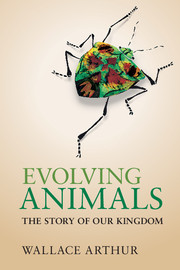Book contents
- Frontmatter
- Dedication
- Contents
- Preface
- Acknowledgements
- 1 What is an animal?
- 2 Before there were animals
- 3 How to make a fossil
- 4 The Cambrian explosion
- 5 How to make a species
- 6 Jellyfish and their kin
- 7 How to make a tree
- 8 The enigmatic urbilaterian
- 9 Animal symmetry and heads
- 10 A plethora of worms
- 11 Trends in animal complexity
- 12 Where the octopus is king
- 13 How to make an animal
- 14 Exoskeletons galore
- 15 Extinction
- 16 Mouth first, mouth second
- 17 Comparing embryos
- 18 Larvae, mouthparts and moulting
- 19 The animal toolkit
- 20 Vertebrate origins and evolution
- 21 From water to land to water
- 22 Variation and inheritance
- 23 Evolutionary novelties
- 24 Human origins and evolution
- 25 Animal plasticity
- 26 The nature of adaptation
- 27 The direction of evolution
- 28 Animal extremophiles
- 29 Extraterrestrial animals?
- 30 The ghost in the machine
- Appendix
- References
- Index
7 - How to make a tree
Published online by Cambridge University Press: 05 August 2014
- Frontmatter
- Dedication
- Contents
- Preface
- Acknowledgements
- 1 What is an animal?
- 2 Before there were animals
- 3 How to make a fossil
- 4 The Cambrian explosion
- 5 How to make a species
- 6 Jellyfish and their kin
- 7 How to make a tree
- 8 The enigmatic urbilaterian
- 9 Animal symmetry and heads
- 10 A plethora of worms
- 11 Trends in animal complexity
- 12 Where the octopus is king
- 13 How to make an animal
- 14 Exoskeletons galore
- 15 Extinction
- 16 Mouth first, mouth second
- 17 Comparing embryos
- 18 Larvae, mouthparts and moulting
- 19 The animal toolkit
- 20 Vertebrate origins and evolution
- 21 From water to land to water
- 22 Variation and inheritance
- 23 Evolutionary novelties
- 24 Human origins and evolution
- 25 Animal plasticity
- 26 The nature of adaptation
- 27 The direction of evolution
- 28 Animal extremophiles
- 29 Extraterrestrial animals?
- 30 The ghost in the machine
- Appendix
- References
- Index
Summary
In the last chapter we looked at an example of how to try to establish the branching pattern of the evolutionary tree that connected three particular groups of animals. Now we broaden out from that starting point to consider how to determine the correct evolutionary tree for any three (or more) animal groups. But there’s a problem lurking here: evolutionary trees are a common way to depict relationships among animals; and, when you see a tree as a picture, it looks like a simple sort of diagram illustrating a simple enough idea. However, the simplicity is illusory in one important way. A picture of a tree may indeed be simple, but how do we know that the particular tree shown is indeed what I called the correct tree above – that is, the one representing the actual pattern of lineage splitting that led to the animal groups concerned?
Let’s take a smaller and more familiar group of animals than those dealt with in the last chapter to see the problem more clearly: the great apes. This term is normally used to include humans, chimps, gorillas and orang-utans but to exclude the closest relatives to that composite group, namely the gibbons. This usage implies that the gibbons are some kind of lesser apes, which is unhelpful, but at least ‘lesser ape’ is a term that is not so often used.
- Type
- Chapter
- Information
- Evolving AnimalsThe Story of our Kingdom, pp. 67 - 76Publisher: Cambridge University PressPrint publication year: 2014



